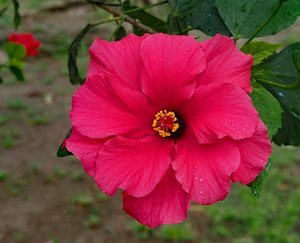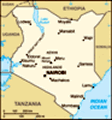Advertisement
Published: June 24th 2023

 Hibiscus
Hibiscus
Early morning at Lake NaivashaThis morning we left to drive the required circuitous route that mainly led south and west. Not far from the city of Lake Naivasha, Steve pointed out two not-quite-clouds. They were two large thermal springs used to make electricity for the area. Soon afterwards, we joined the Rift Valley, and the hundreds of trucks on the Trans African Highway.
Along the way were a smaller and then a larger truck stop that accommodate the needs of drivers and their vehicles. Unfortunately, all such truck stops along the highway are notorious for the spread of HIV, from men to sex-workers to other men and to their families, a major cause of HIV among married women and their newborn children. Lucas described this, although I was familiar with the issues from my reading. The truck stops were almost towns in their own right, providing restaurants, minimal hotels, vehicle repair services, barber shops, and convenience stores.
As we turned west off the Trans African Highway, we took note of shovels stuck in the ground. Lucas explained that young men each had their own shovel and were waiting for jobs. They dug sand out of a relatively nearby quarry. Haulage trucks would come
to where groups of men waited. The drivers would call out the number of diggers wanted. The young men grabbed their shovels, were driven to the quarry, dug as fast as possible, and were driven back to wait for another job. All the fees were fixed, so everyone wanted as many jobs as possible per day.
Farther along, we could see in the far distance a huge cattle market. Deals for cattle, goats and feed were being made. On the sides of the road, we saw herders walking towards the market with their cattle for sale or walking back with a few cattle. Larger herds were carried in trucks. For a long way, road signs indicated cattle-crossing areas, urging drivers to take care. Of course, lots of other services were busy catering to the influx of people.
The road rose out of the valley. On top, fields of wheat and corn had been harvested; next planting is in January or February. This area is known as the bread basket of Kenya. The growing of crops is threatening the traditional way of life for the Maasai, because one acre of wheat is more valuable than a bull calf raised
for three years. The Maasai are trying hard to maintain their traditions, but technology, education and market forces are eroding them.
For a long way we repeatedly entered and left the Rift Valley. For the most part, the bottom is a grassland plain, whereas the hills are covered with trees and bushes. In certain towns, road-side stalls sold fruits and vegetables, particularly onions in 5 kilo (perhaps) mesh bags, cabbages in full leaf, and fat pineapples.
We passed through the largest town in the Maasai Mara, Narok. It is spread out like a small city and is the district county capital. We drove on through to the purpose-built Oasis Restaurant, where travellers could get roasted meats, snacks, and soft drinks. A lot of tables were in a large hall where people could eat and rest. We looked around with curiosity and bought coconut biscuits, courtesy of Lucas.
I was glad of the biscuits, because we soon turned off onto the rough road to our still-distant destination. Having been warned, we all bounced with the jolting. My attention was taken with the villages, farms, people and varying landscape. It seemed odd that within a few minutes the view
changed from a dry plain dotted with ant and termite nests (black mounds) to groves of flat-topped acacia trees. The broad shape of these trees is so iconic it immediately says Africa. Many cattle herds used the land; they are considered part of the natural environment, because they eat hard grasses that other animals won’t, their hooves cut into the surface of the soil, and they provide fertilizer, as all animals do. On the dried mud and gravel road, we swung side to side depending on Steve’s judgement of the smoothest line. We passed many motorcycles, mainly ridden by men, but not exclusively. Other vehicles passed us, of course, and there were still a number of trucks to contend with. Occasionally, someone walking along would give a friendly wave, so I began to do the same. Most people grinned and waved back. The school children were enthusiastic greeters.
About 1:00 we pulled off the road to have a boxed lunch. Not really a picnic, since the condition of the ground dictated that we stood and used the vehicle hoods as tables. Just as we pulled in, we saw our first Topis, a large antelope with "blue jeans", which are
denim-blue patches on their legs. A couple of us saw a couple of giraffes peering over some trees, but I didn’t. All of the animals must have disapproved of our noise and bustle, because they disappeared into the brush. (Each of us also retired for a few moments behind a convenient large bush.) Later, a curious herder was greeted by Lucas and was given the parts of our lunches that no one wanted. Not sure what he thought of the fare.
View map to date.
Advertisement
Tot: 0.051s; Tpl: 0.013s; cc: 11; qc: 24; dbt: 0.0204s; 1; m:domysql w:travelblog (10.17.0.13); sld: 1;
; mem: 1.1mb
























Isabel Gibson
non-member comment
:-) Most people do seem to be happy to be greeted/acknowledged, don't they? Even that small connection gives some pleasure. As for the poles in the timber yard, um, yeah. Presumably they're good for something, but it sure doesn't leap to my mind. I wonder what they'd think of our lumberyards. I was curious as to why farmers would have tolerated (protected? cultivated?) trees in the middle of their corn field, so I looked them up and, of course, they have economic/utility benefits beyond giving shade and posing for photographs. I didn't quite understand how the road came to be going in and out of the Rift Valley. A series of highlands cutting more or less across your direction of travel?